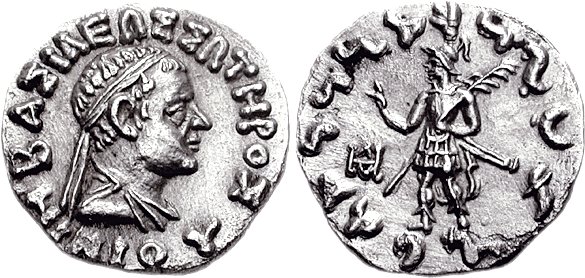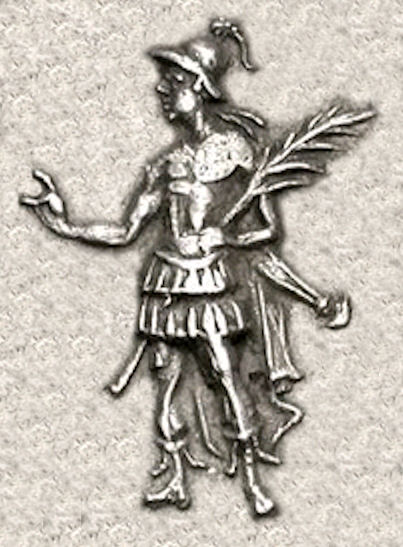Nicias (Indo-Greek king) on:
[Wikipedia]
[Google]
[Amazon]
 Nicias (
Nicias (

 Nicias struck Indian silver drachms of diademed or helmeted king with three reverses:
*A standing king in armour making a blessing gesture, found on several drachms.
*An en face version of Menander's Athena with thunderbolt is found on a unique tetradrachm.
*The third reverse is the type king on a prancing horse, as used by
Nicias struck Indian silver drachms of diademed or helmeted king with three reverses:
*A standing king in armour making a blessing gesture, found on several drachms.
*An en face version of Menander's Athena with thunderbolt is found on a unique tetradrachm.
*The third reverse is the type king on a prancing horse, as used by
Indo-Greek history and coins
* ttps://www.academia.edu/36456046/LE_ROI_INDO-GREC_NICIAS_LE_SAUVEUR_par_Roger_COTTEREAU Le Roi indo-grec Nicias Le Sauveur {{Hellenistic rulers Nic Nic
 Nicias (
Nicias (Greek
Greek may refer to:
Greece
Anything of, from, or related to Greece, a country in Southern Europe:
*Greeks, an ethnic group.
*Greek language, a branch of the Indo-European language family.
**Proto-Greek language, the assumed last common ancestor ...
: ) was an Indo-Greek
The Indo-Greek Kingdom, or Graeco-Indian Kingdom, also known historically as the Yavana Kingdom (Yavanarajya), was a Hellenistic-era Greek kingdom covering various parts of Afghanistan and the northwestern regions of the Indian subcontinent ( ...
king who ruled in the Paropamisade. Most of his relatively few coins have been found in northern Pakistan
Pakistan ( ur, ), officially the Islamic Republic of Pakistan ( ur, , label=none), is a country in South Asia. It is the world's fifth-most populous country, with a population of almost 243 million people, and has the world's second-lar ...
, indicating that he ruled a smaller principate around the lower Kabul
Kabul (; ps, , ; , ) is the capital and largest city of Afghanistan. Located in the eastern half of the country, it is also a municipality, forming part of the Kabul Province; it is administratively divided into 22 municipal districts. Acco ...
valley.
He was possibly a relative of Menander I
Menander I Soter ( grc, Μένανδρος Σωτήρ, Ménandros Sōtḗr, Menander the Saviour; pi, मिलिन्दो, Milinda), was a Greco-Bactrian and later Indo-Greek King (reigned c.165/155Bopearachchi (1998) and (1991), respectivel ...
.
Time of reign
Bopearachchi suggests that Nicias ruled c. 90–85 BCE. This late date is supported by the absence of Attic coins (see below). R. C. Senior on the other hand places him as a successor of Menander, c. 135–125 BCE, according to his interpretation of hoard findings. Regardless of which period is correct, the fact that Nicias ages visibly on his coins seems to indicate some longevity to his rule.The coinage of Nicias

 Nicias struck Indian silver drachms of diademed or helmeted king with three reverses:
*A standing king in armour making a blessing gesture, found on several drachms.
*An en face version of Menander's Athena with thunderbolt is found on a unique tetradrachm.
*The third reverse is the type king on a prancing horse, as used by
Nicias struck Indian silver drachms of diademed or helmeted king with three reverses:
*A standing king in armour making a blessing gesture, found on several drachms.
*An en face version of Menander's Athena with thunderbolt is found on a unique tetradrachm.
*The third reverse is the type king on a prancing horse, as used by Antimachus II
Antimachus II Nikephoros ( Greek: ; the epithet means "the Victorious") was an Indo-Greek king. He ruled a vast territory from the Hindu-Kush to the Punjab around 170 BCE. He was almost certainly the eponymous son of Antimachus I, who is known ...
found on a single drachm.
His bronzes feature Zeus/dolphin or portrait / king on prancing horse. Some varieties are crude with lunate sigmas and square omicrons. Even though Nikias ruled in the western parts of the Indo-Greek realm, no Attic coins have been found.
His monograms generally match those of the kings Theophilus
Theophilus is a male given name with a range of alternative spellings. Its origin is the Greek word Θεόφιλος from θεός (God) and φιλία (love or affection) can be translated as "Love of God" or "Friend of God", i.e., it is a theoph ...
and Philoxenus, though one is shared with Thrason
Thraso (Greek: ), latinized as Thrason, was an Indo-Greek king in Central and Western Punjab, unknown until the 1982 discovery of one of his coins by R. C. Senior in the Surana hoard. The coin is in a style similar to those of Menander I, has the s ...
, the short-lived son of Menander I.
See also
* Greco-Bactrian Kingdom * Seleucid Empire *Greco-Buddhism
Greco-Buddhism, or Graeco-Buddhism, is the cultural syncretism between Hellenistic culture and Buddhism, which developed between the fourth century BC and the fifth century AD in Gandhara, in present-day north-western Pakistan and parts of nort ...
* Indo-Scythians
Indo-Scythians (also called Indo-Sakas) were a group of nomadic Iranian peoples of Scythian origin who migrated from Central Asia southward into modern day Pakistan and Northwestern India from the middle of the 2nd century BCE to the 4th centu ...
* Indo-Parthian Kingdom
The Indo-Parthian Kingdom was a Parthian kingdom founded by Gondophares, and active from 19 CE to c. 226 CE. At their zenith, they ruled an area covering parts of eastern Iran, various parts of Afghanistan and the northwest regions of the Indian s ...
* Kushan Empire
References
* ''The Shape of Ancient Thought. Comparative studies in Greek and Indian Philosophies'' by Thomas McEvilley (Allworth Press and the School of Visual Arts, 2002) * ''The Greeks in Bactria and India'', W.W. Tarn, Cambridge University Press.External links
Indo-Greek history and coins
* ttps://www.academia.edu/36456046/LE_ROI_INDO-GREC_NICIAS_LE_SAUVEUR_par_Roger_COTTEREAU Le Roi indo-grec Nicias Le Sauveur {{Hellenistic rulers Nic Nic